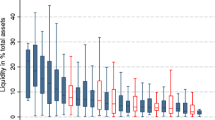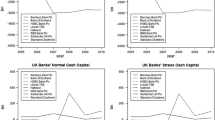Abstract
The paper examines the impact from liquidity reserves on banks’ lending. Analysing a large sample of US banks, we discover that the lending of our firms is lower when they hoard liquidity in the form of cash, inter-bank deposits, or through transactions on federal funds. Further results reveal that the effect is stronger after the last quarter of 2008, namely after that the Federal Reserve started to pay interests on banks’ reserves. The paper contributes to the discussion around the implications on the credit to the real economy from central banks’ interventions of monetary policy and in particular from the discipline of reserves.



Similar content being viewed by others
Notes
Board of Governors of the Federal Reserve System, 2016, Reserve Requirements, Available at https://www.federalreserve.gov/monetarypolicy/reservereq.htm.
Board of Governors of the Federal Reserve System, 2008, “Board announces that it will begin to pay interest on depository institutions’ required and excess reserve balances,” Press release, October 6. Available at www.federalreserve.gov/newsevents/press/other/20081008a.htm.
According to the Financial Services Regulatory Relief Act of 2006, Congress authorized the Fed to pay interest on reserves effective 1 October 2011, but its implementation moved up to 1 October 2008, as part of the Fed’s response to the financial crisis.
See www.snl.com.
See the “Instructions for Preparation of Consolidated Reports of Condition and Income” from the Federal Financial Institutions Examination Council's (FFIEC) at www.ffiec.gov.
See the definition in the forms 10-K and 10-Q filled to the United States Securities and Exchange Commission—SEC (www.sec.gov).
In Eq. (1), we use the figure for gross loans, which includes loan-loss reserves. We checked that the quality of the empirical results does not change when we employ the item for net loans, where loans are net of loan-loss reserves.
Mankiw [5] mentions the proposal made by the German economist Silvio Gesell in the late nineteenth century, to tax the holding money in order to encourage lending.
References
Williamson, S.D. 2015. Monetary Policy Normalization in the United States. Federal Reserve Bank of St. Louis Review 97(2): 87–108.
Williamson, S.D. 2016. Interest Rate Control is More Complicated Than You Thought. Federal Reserve Bank of St. Louis. The Regional Economist. Available at https://www.stlouisfed.org/publications/regional-economist/april-2016/interest-rate-control-is-more-complicated-than-you-thought.
Keister, T., and J.J. McAndrews. 2009. Why are Banks Holding So Many Excess Reserves? Federal Reserve Bank of New York Current Issues in Economics and Finance 15(8): 1–10.
Stiglitz, J.E., and H. Rashid. 2012. What’s Holding Back the World Economy?. Available at https://www.project-syndicate.org/commentary/whats-holding-back-the-global-economy-by-joseph-e–stiglitz-and-hamid-rashid-2016-02.
Mankiw, N.G. 2009. It May Be Time for the Fed to Go Negative. New York Times, April 19.
Edlin, A.S., and D.M. Jaffee. 2009. Show Me the Money. The Economists’ Voice 6(4): 8.
Selgin, G. 2016. Interest on Reserves and the Fed’s Balance Sheet. Available at http://www.cato.org/publications/testimony/interest-reserves-feds-balance-sheet.
Keen, S. 2016. Hey Joe Banks Can’t Lend Out Reserves. Available at http://www.forbes.com/sites/stevekeen/2016/02/12/hey-joe-banks-cant-lend-out-reserves/6/#7e8237612465.
Coppola, F. 2016. It was the Financial Crisis that Stopped Banks Lending not Interest on Excess Reserves. Available at http://www.forbes.com/sites/francescoppola/2016/01/12/it-was-the-financial-crisis-that-stopped-banks-lending-not-interest-on-excess-reserves/2/#4b9ecedb7cf4.
Sumner, S. 2009. Comment on Brad Delong: Can We Generate Controlled Reflation in a Liquidity Trap? The Economists’ Voice 6(4): 7.
Dasgupta, S. 2009. Comment on Luigi Zingales: Why Not Consider Maximum Reserve Ratios? The Economists’ Voice 6(4): 6.
Goodfriend, M. 2002. Interest on Reserves and Monetary Policy. Federal Reserve Bank of New York Economic Policy Review 8(1): 13–29.
Woodford, M. 2000. Monetary Policy in a World Without Money. International Finance 3(2): 229–260.
Author information
Authors and Affiliations
Corresponding author
Appendix
Appendix
Variable name | Description |
|---|---|
Cash (000$) | Cash and cash equivalents |
Deposits at banks (000$) | Interest-bearing deposits at other financial institutions |
Fed funds (000$) | Overnight deposits at a Federal Reserve bank and securities purchased under agreements to resell |
Loans (000$) | Loans and finance leases held for investment or held for sale, net of unearned discount, and gross of loss reserves. Does not include accrued interest on loans |
Assets (000$) | Total assets |
Size | Natural logarithm of total assets |
ROA (%) | Return on average assets; net income as a percentage of average assets |
Equity (000$) | Total equity |
Risk-weighted capital ratio (%) | Sum of Tier 1 and Tier 2 capital over risk-weighted assets |
Fed funds rate | Fed funds rate at the end of the specified period |
Low capital | Dummy variable taking value one if the company’s equity/assets is less than the median equity/assets (equal to 10.02%) |
Low reg capital | Dummy variable taking value one if the company’s risk-weighted capital ratio is less than the median risk-weighted capital ratio (equal to 14.93%) |
2008q4 | Dummy variable taking value one if the data is observed during 2008q4 |
Post2008q4 | Dummy variable taking value one if the data is observed during 2008q4–2016q2 |




